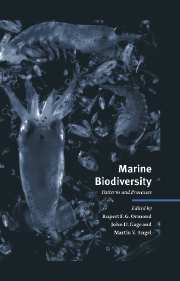Book contents
- Frontmatter
- Contents
- List of contributors
- Foreword: The value of diversity
- 1 Marine biodiversity in its global context
- 2 Gradients in marine biodiversity
- 3 Pelagic biodiversity
- 4 Biological diversity in oceanic macrozooplankton: More than counting species
- 5 Large-scale patterns of species diversity in the deep-sea benthos
- 6 Diversity, latitude and time: Patterns in the shallow sea
- 7 High benthic species diversity in deep-sea sediments: The importance of hydrodynamics
- 8 Diversity and structure of tropical Indo-Pacific benthic communities: Relation to regimes of nutrient input
- 9 Why are coral reef communities so diverse?
- 10 The biodiversity of coral reef fishes
- 11 The historical component of marine taxonomic diversity gradients
- 12 Population genetics and demography of marine species
- 13 Discovering unrecognised diversity among marine molluscs
- 14 Ecosystem function at low biodiversity – the Baltic example
- 15 Land–seascape diversity of the USA East Coast coastal zone with particular reference to estuaries
- 16 The development of mariculture and its implications for biodiversity
- 17 Protecting marine biodiversity and integrated coastal zone management
- 18 Conserving biodiversity in North-East Atlantic marine ecosystems
- Author index
- Species index
- Subject index
17 - Protecting marine biodiversity and integrated coastal zone management
Published online by Cambridge University Press: 04 August 2010
- Frontmatter
- Contents
- List of contributors
- Foreword: The value of diversity
- 1 Marine biodiversity in its global context
- 2 Gradients in marine biodiversity
- 3 Pelagic biodiversity
- 4 Biological diversity in oceanic macrozooplankton: More than counting species
- 5 Large-scale patterns of species diversity in the deep-sea benthos
- 6 Diversity, latitude and time: Patterns in the shallow sea
- 7 High benthic species diversity in deep-sea sediments: The importance of hydrodynamics
- 8 Diversity and structure of tropical Indo-Pacific benthic communities: Relation to regimes of nutrient input
- 9 Why are coral reef communities so diverse?
- 10 The biodiversity of coral reef fishes
- 11 The historical component of marine taxonomic diversity gradients
- 12 Population genetics and demography of marine species
- 13 Discovering unrecognised diversity among marine molluscs
- 14 Ecosystem function at low biodiversity – the Baltic example
- 15 Land–seascape diversity of the USA East Coast coastal zone with particular reference to estuaries
- 16 The development of mariculture and its implications for biodiversity
- 17 Protecting marine biodiversity and integrated coastal zone management
- 18 Conserving biodiversity in North-East Atlantic marine ecosystems
- Author index
- Species index
- Subject index
Summary
Abstract
Human pressure on the marine environment has never been so intense. Many human-induced physical, chemical and biological changes are adversely affecting biological diversity, and a range of activities are currently resulting in widespread degradation or even complete destruction of different marine habitats. In particular impacts due to development, and conflicts of interest over resource use, are most acute in the coastal zone. Yet it is here that productivity and biodiversity are generally greatest. Integrated Coastal Zone Management (ICZM) is increasingly recognised as essential for securing the sustainable development of resources and the effective management of coastal and marine areas under national jurisdiction. This chapter describes the typical elements of ICZM and discusses key policy considerations. However the full potential of ICZM for maintaining and enhancing marine biodiversity has yet to be realised.
Introduction
The protection and management of biological diversity is now firmly established on the international agenda. While ecologists and environmentalists have long recognised the importance of documenting, studying and maintaining biodiversity, it was only in 1992, following years of discussion, that the Convention on Biological Diversity was agreed, and even more recently ratified (UNCED, 1992a). The objectives of the Convention are to conserve biodiversity, to achieve the sustainable use of its components, and to secure the fair and equitable sharing of the genetic resources which that biodiversity represents.
- Type
- Chapter
- Information
- Marine BiodiversityPatterns and Processes, pp. 394 - 414Publisher: Cambridge University PressPrint publication year: 1997
- 3
- Cited by

